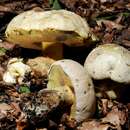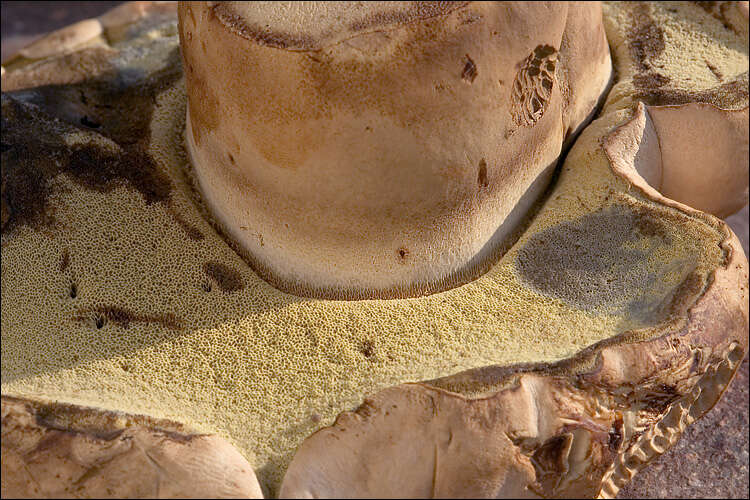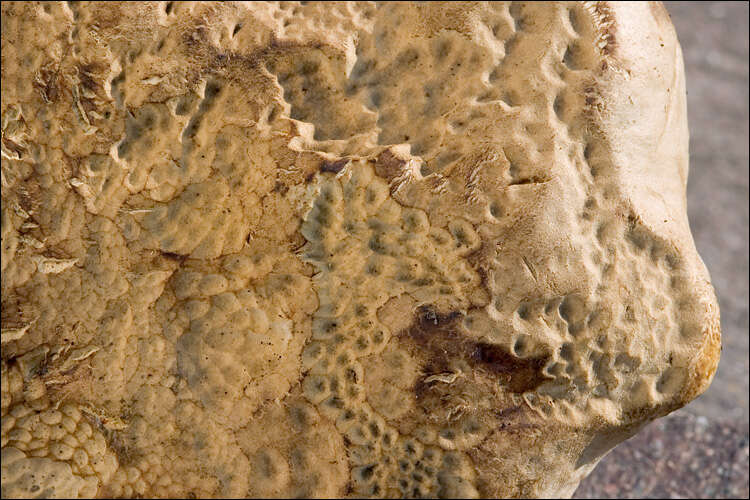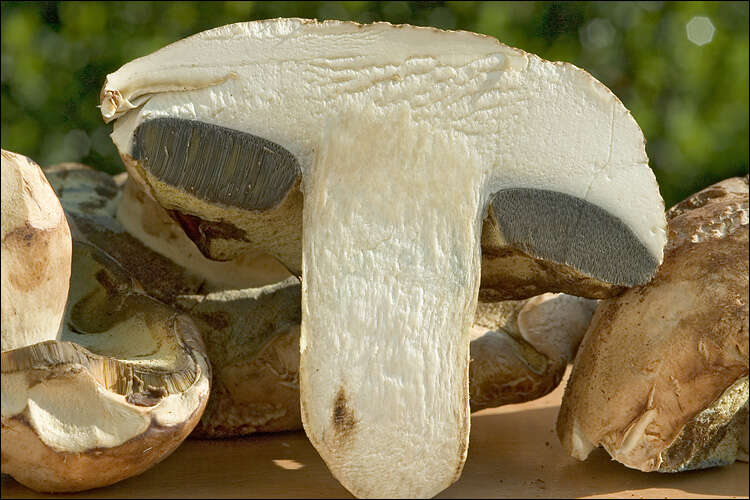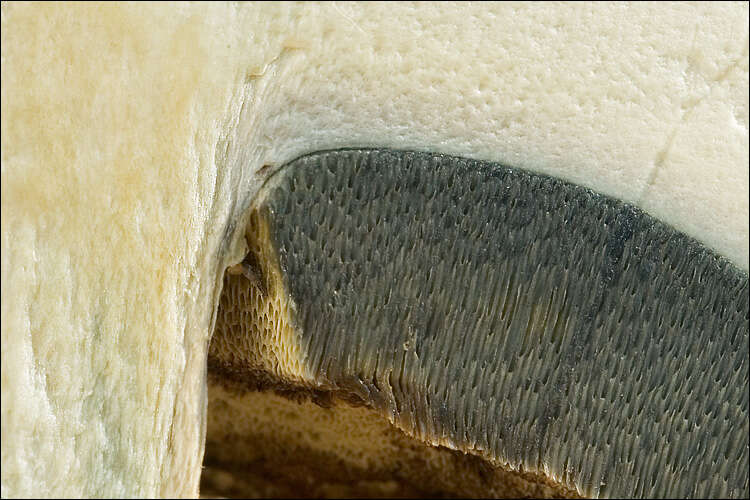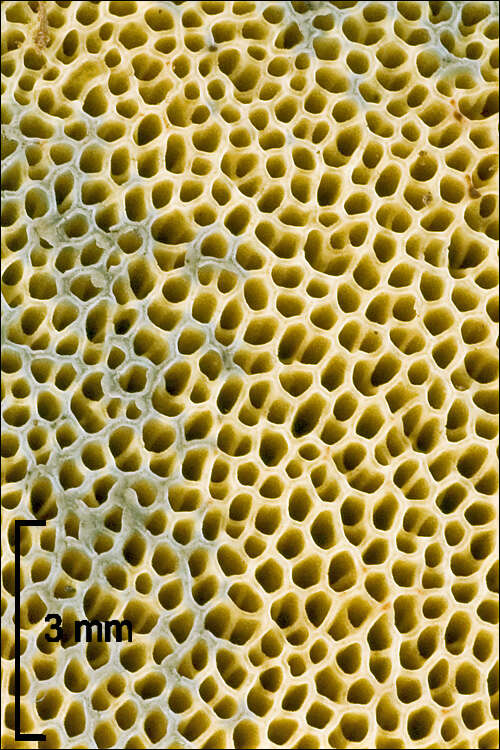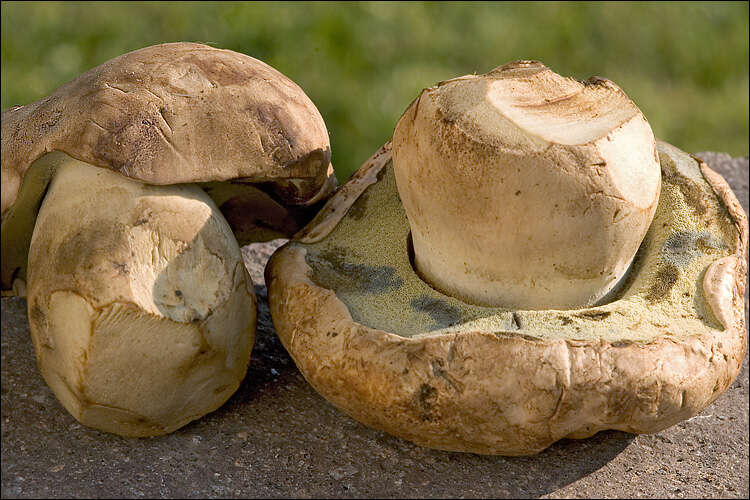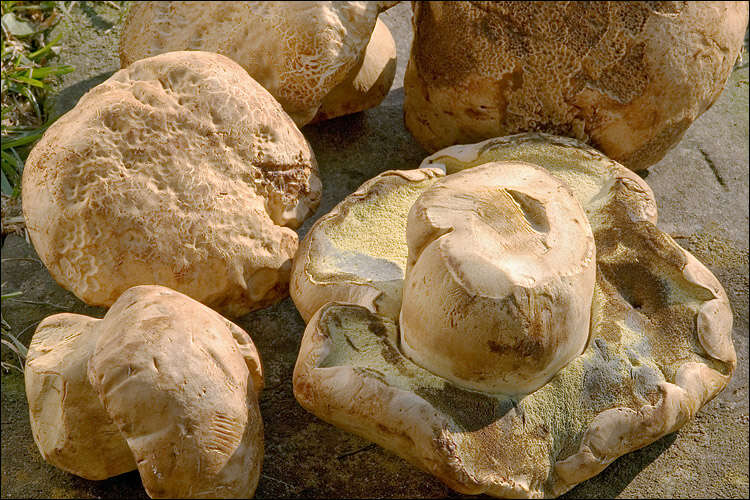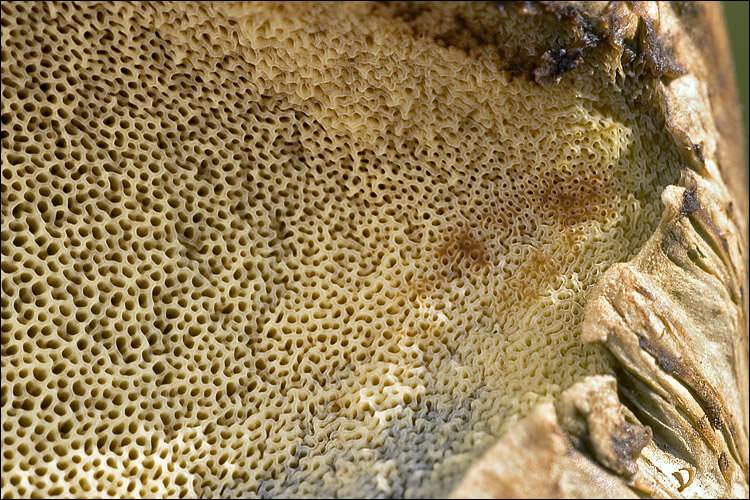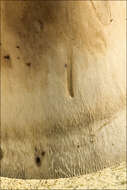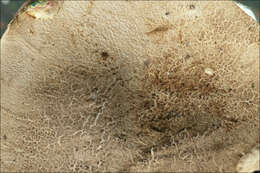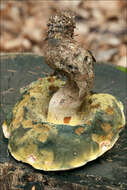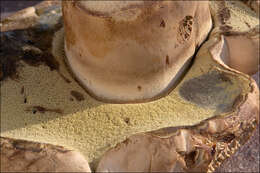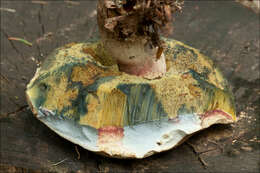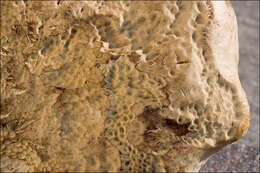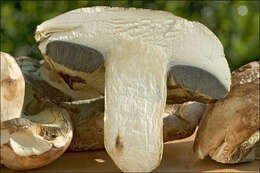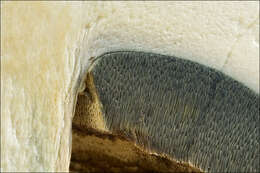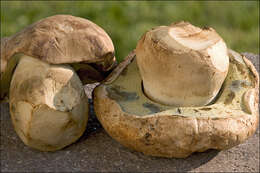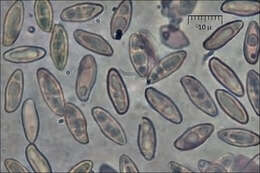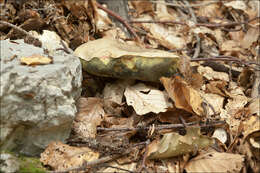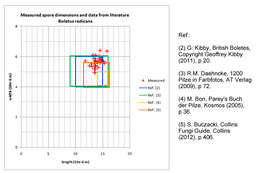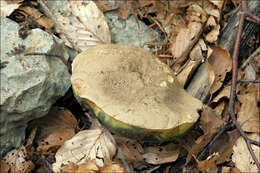-
Boletus radicans, syn. Boletus albidusWhitish bolete , Rooting bolete Slo.: grenki gobanDate: August 21. 2009Lat.: 46.3929 Long.: 14.08478Code: Bot_373/2009-2470Habitat: Grassland with some bushes and Fagus sylvatica, mostly open place, pretty sunny, precipitations 1.800-2.000 mm/year, average temperature 8-10 deg C, elevation 600 m (1.970 feet), alpine phytogeographical region.Place: Blejski vintgar gorge, northwest of Bled, Gorenjska, Slovenia ECNikon D70 / Nikorr Micro 105mm/f2.8
-
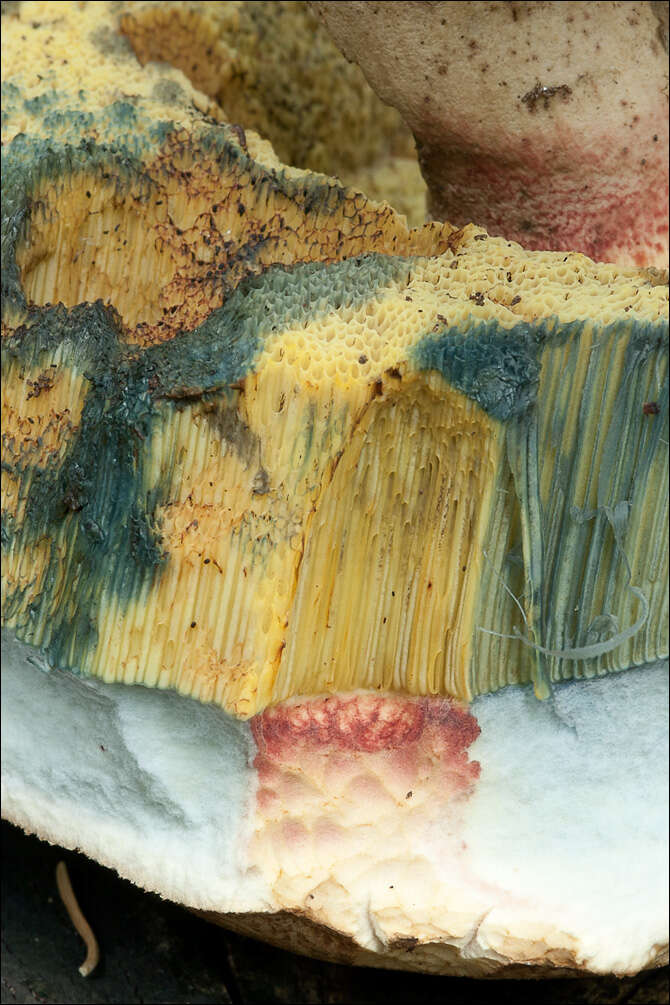
Boletus radicans (Pers.) Fr. syn. Boletus albidusWhitish bolete , Rooting bolete, DE: Wurzelnder BitterrhrlingSlo.: grenki gobanDat.: Jul. 16. 2015Lat.: 46.41048 Long.: 13.75046Code: Bot_902/2015_DSC7918Habitat: mixed mountain wood, dominant trees Fagus sylvatica and Picea abies; moderately steep mountain slope, south aspect; calcareous ground; in shade; partly protected from direct rain by tree canopies; average precipitations ~ 3.000 mm/year, average temperature 3-5 deg C, elevation 1.260 m (4.150 feet), alpine phytogeographical region.Substratum: forest soil.Place: Trenta valley, near Vri pass road, southwest slopes of Mt. Prisank, 2.547 , (8.357 feet), East Julian Alps, Posoje, Slovenia EC.Comments: Texture and color of the upper surface of the hut, rooting stipe, turning blue on bruising and, in particular, very strong bitter taste are typical traits of Boletus radicans. What surprises in this find is reddish coloration of damaged places (by snails) and quite distinctive reddish tones of the stipe. This is unusual with Boletus radicans and causes some doubts in our determination. However, no better alternatives have been found. Growing solitary; pileus diameter 8.5 cm; taste strongly bitter, smell faint, unpleasant; quickly bruising blue-green when handled; SP faint, color indistinguishable. Spores smooth. Dimensions: 12.4 [13.7 ; 14.2] 15.5 x 5 [5.5 ; 5.8] 6.3 microns Q = 2.2 [2.4 ; 2.5] 2.8; N = 34; C = 95%; Me = 14 x 5.6 microns; Qe = 2,5. Olympus CH20, NEA 100x/1.25, magnification 1.000 x, oil; in water. AmScope MA500 digital camera.Herbarium: Mycotheca and lichen herbarium (LJU-Li) of Slovenian Forestry Institute, Vena pot 2, Ljubljana, Index Herbariorum LJFRef.:(1) Personal communication with Mr. Bojan Rot and (conf.) Mr. Anton Poler.(2) G. Kibby, British Boletes, Copyright Geoffrey Kibby (2011), p 20. (3) R.M. Daehncke, 1200 Pilze in Farbfotos, AT Verlag (2009), p 72. (4) M. Bon, Parey's Buch der Pilze, Kosmos (2005), p 36. (5) S. Buczacki, Collins Fungi Guide, Collins (2012), p 406.
-
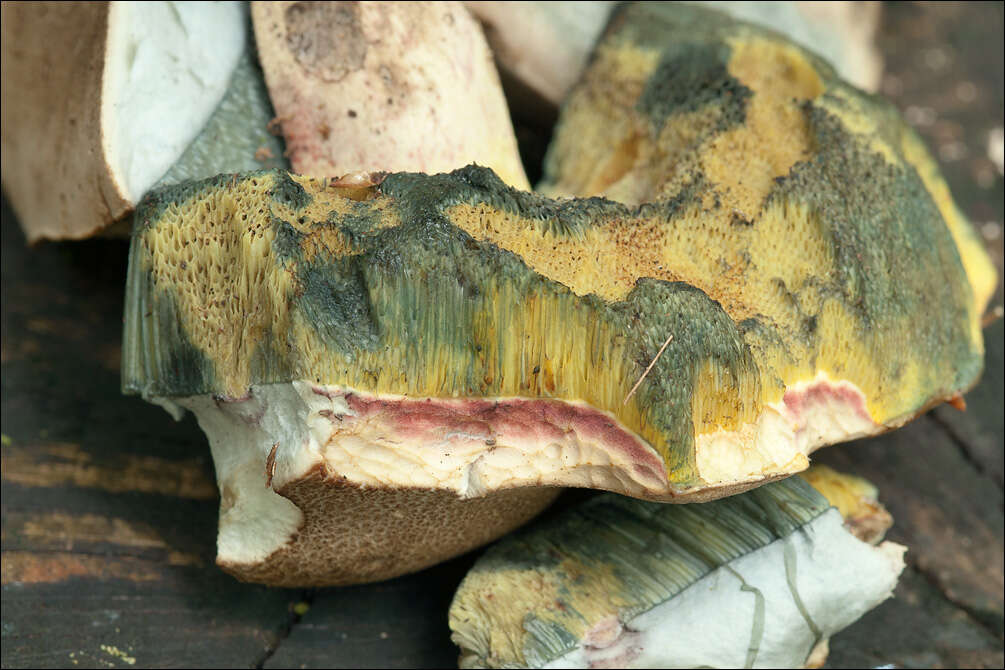
Boletus radicans (Pers.) Fr. syn. Boletus albidusWhitish bolete , Rooting bolete, DE: Wurzelnder BitterrhrlingSlo.: grenki gobanDat.: Jul. 16. 2015Lat.: 46.41048 Long.: 13.75046Code: Bot_902/2015_DSC7918Habitat: mixed mountain wood, dominant trees Fagus sylvatica and Picea abies; moderately steep mountain slope, south aspect; calcareous ground; in shade; partly protected from direct rain by tree canopies; average precipitations ~ 3.000 mm/year, average temperature 3-5 deg C, elevation 1.260 m (4.150 feet), alpine phytogeographical region.Substratum: forest soil.Place: Trenta valley, near Vri pass road, southwest slopes of Mt. Prisank, 2.547 , (8.357 feet), East Julian Alps, Posoje, Slovenia EC.Comments: Texture and color of the upper surface of the hut, rooting stipe, turning blue on bruising and, in particular, very strong bitter taste are typical traits of Boletus radicans. What surprises in this find is reddish coloration of damaged places (by snails) and quite distinctive reddish tones of the stipe. This is unusual with Boletus radicans and causes some doubts in our determination. However, no better alternatives have been found. Growing solitary; pileus diameter 8.5 cm; taste strongly bitter, smell faint, unpleasant; quickly bruising blue-green when handled; SP faint, color indistinguishable. Spores smooth. Dimensions: 12.4 [13.7 ; 14.2] 15.5 x 5 [5.5 ; 5.8] 6.3 microns Q = 2.2 [2.4 ; 2.5] 2.8; N = 34; C = 95%; Me = 14 x 5.6 microns; Qe = 2,5. Olympus CH20, NEA 100x/1.25, magnification 1.000 x, oil; in water. AmScope MA500 digital camera.Herbarium: Mycotheca and lichen herbarium (LJU-Li) of Slovenian Forestry Institute, Vena pot 2, Ljubljana, Index Herbariorum LJFRef.:(1) Personal communication with Mr. Bojan Rot and (conf.) Mr. Anton Poler.(2) G. Kibby, British Boletes, Copyright Geoffrey Kibby (2011), p 20. (3) R.M. Daehncke, 1200 Pilze in Farbfotos, AT Verlag (2009), p 72. (4) M. Bon, Parey's Buch der Pilze, Kosmos (2005), p 36. (5) S. Buczacki, Collins Fungi Guide, Collins (2012), p 406.
-
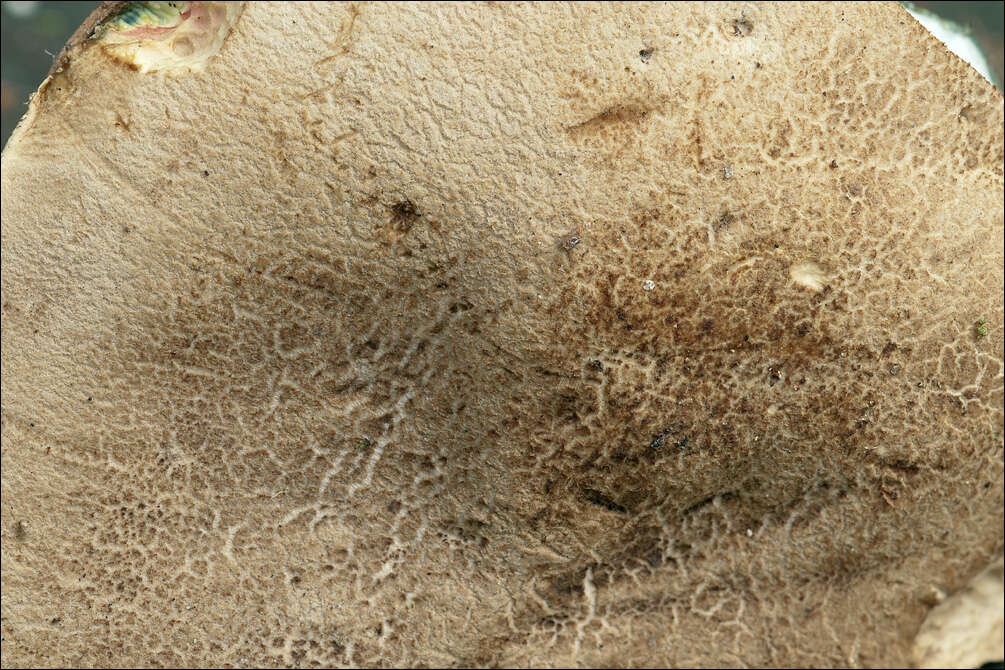
Boletus radicans (Pers.) Fr. syn. Boletus albidusWhitish bolete , Rooting bolete, DE: Wurzelnder BitterrhrlingSlo.: grenki gobanDat.: Jul. 16. 2015Lat.: 46.41048 Long.: 13.75046Code: Bot_902/2015_DSC7918Habitat: mixed mountain wood, dominant trees Fagus sylvatica and Picea abies; moderately steep mountain slope, south aspect; calcareous ground; in shade; partly protected from direct rain by tree canopies; average precipitations ~ 3.000 mm/year, average temperature 3-5 deg C, elevation 1.260 m (4.150 feet), alpine phytogeographical region.Substratum: forest soil.Place: Trenta valley, near Vri pass road, southwest slopes of Mt. Prisank, 2.547 , (8.357 feet), East Julian Alps, Posoje, Slovenia EC.Comments: Texture and color of the upper surface of the hut, rooting stipe, turning blue on bruising and, in particular, very strong bitter taste are typical traits of Boletus radicans. What surprises in this find is reddish coloration of damaged places (by snails) and quite distinctive reddish tones of the stipe. This is unusual with Boletus radicans and causes some doubts in our determination. However, no better alternatives have been found. Growing solitary; pileus diameter 8.5 cm; taste strongly bitter, smell faint, unpleasant; quickly bruising blue-green when handled; SP faint, color indistinguishable. Spores smooth. Dimensions: 12.4 [13.7 ; 14.2] 15.5 x 5 [5.5 ; 5.8] 6.3 microns Q = 2.2 [2.4 ; 2.5] 2.8; N = 34; C = 95%; Me = 14 x 5.6 microns; Qe = 2,5. Olympus CH20, NEA 100x/1.25, magnification 1.000 x, oil; in water. AmScope MA500 digital camera.Herbarium: Mycotheca and lichen herbarium (LJU-Li) of Slovenian Forestry Institute, Vena pot 2, Ljubljana, Index Herbariorum LJFRef.:(1) Personal communication with Mr. Bojan Rot and (conf.) Mr. Anton Poler.(2) G. Kibby, British Boletes, Copyright Geoffrey Kibby (2011), p 20. (3) R.M. Daehncke, 1200 Pilze in Farbfotos, AT Verlag (2009), p 72. (4) M. Bon, Parey's Buch der Pilze, Kosmos (2005), p 36. (5) S. Buczacki, Collins Fungi Guide, Collins (2012), p 406.
-
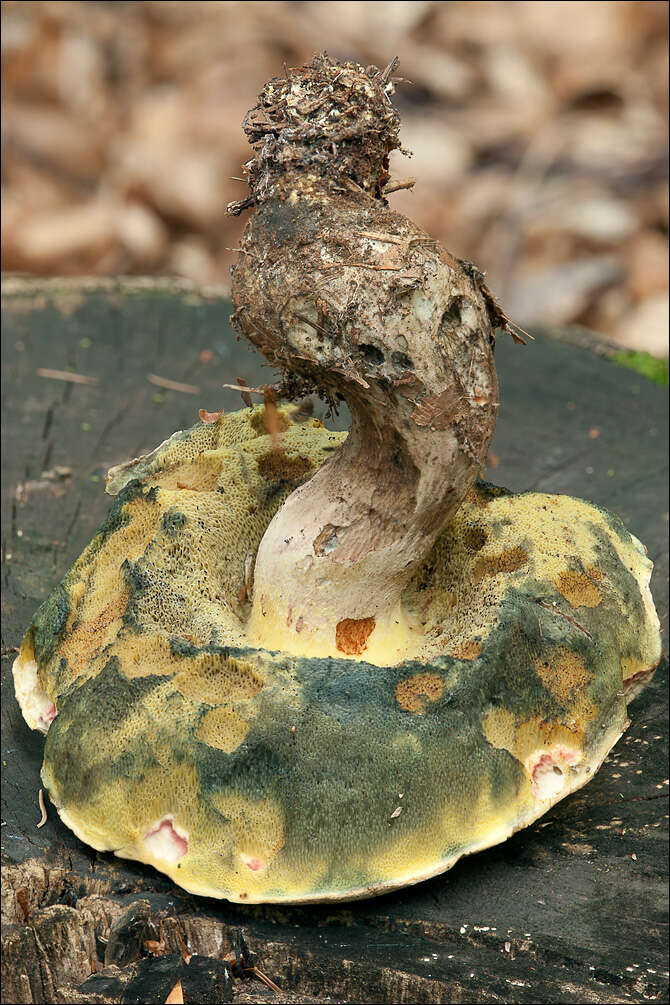
Boletus radicans (Pers.) Fr. syn. Boletus albidusWhitish bolete , Rooting bolete, DE: Wurzelnder BitterrhrlingSlo.: grenki gobanDat.: Jul. 16. 2015Lat.: 46.41048 Long.: 13.75046Code: Bot_902/2015_DSC7918Habitat: mixed mountain wood, dominant trees Fagus sylvatica and Picea abies; moderately steep mountain slope, south aspect; calcareous ground; in shade; partly protected from direct rain by tree canopies; average precipitations ~ 3.000 mm/year, average temperature 3-5 deg C, elevation 1.260 m (4.150 feet), alpine phytogeographical region.Substratum: forest soil.Place: Trenta valley, near Vri pass road, southwest slopes of Mt. Prisank, 2.547 , (8.357 feet), East Julian Alps, Posoje, Slovenia EC.Comments: Texture and color of the upper surface of the hut, rooting stipe, turning blue on bruising and, in particular, very strong bitter taste are typical traits of Boletus radicans. What surprises in this find is reddish coloration of damaged places (by snails) and quite distinctive reddish tones of the stipe. This is unusual with Boletus radicans and causes some doubts in our determination. However, no better alternatives have been found. Growing solitary; pileus diameter 8.5 cm; taste strongly bitter, smell faint, unpleasant; quickly bruising blue-green when handled; SP faint, color indistinguishable. Spores smooth. Dimensions: 12.4 [13.7 ; 14.2] 15.5 x 5 [5.5 ; 5.8] 6.3 microns Q = 2.2 [2.4 ; 2.5] 2.8; N = 34; C = 95%; Me = 14 x 5.6 microns; Qe = 2,5. Olympus CH20, NEA 100x/1.25, magnification 1.000 x, oil; in water. AmScope MA500 digital camera.Herbarium: Mycotheca and lichen herbarium (LJU-Li) of Slovenian Forestry Institute, Vena pot 2, Ljubljana, Index Herbariorum LJFRef.:(1) Personal communication with Mr. Bojan Rot and (conf.) Mr. Anton Poler.(2) G. Kibby, British Boletes, Copyright Geoffrey Kibby (2011), p 20. (3) R.M. Daehncke, 1200 Pilze in Farbfotos, AT Verlag (2009), p 72. (4) M. Bon, Parey's Buch der Pilze, Kosmos (2005), p 36. (5) S. Buczacki, Collins Fungi Guide, Collins (2012), p 406.
-
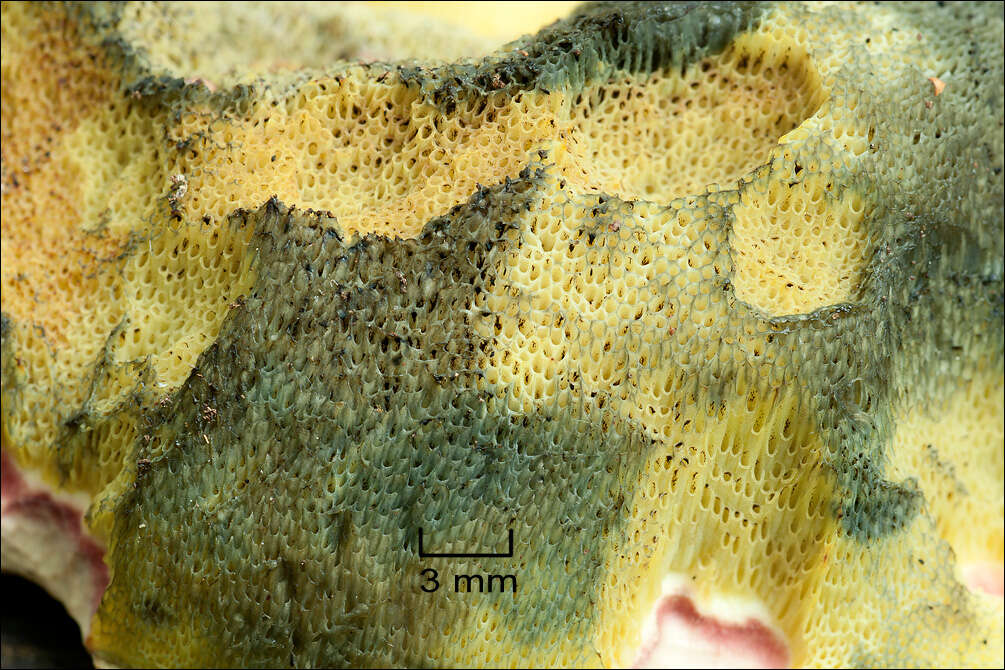
Boletus radicans (Pers.) Fr. syn. Boletus albidusWhitish bolete , Rooting bolete, DE: Wurzelnder BitterrhrlingSlo.: grenki gobanDat.: Jul. 16. 2015Lat.: 46.41048 Long.: 13.75046Code: Bot_902/2015_DSC7918Habitat: mixed mountain wood, dominant trees Fagus sylvatica and Picea abies; moderately steep mountain slope, south aspect; calcareous ground; in shade; partly protected from direct rain by tree canopies; average precipitations ~ 3.000 mm/year, average temperature 3-5 deg C, elevation 1.260 m (4.150 feet), alpine phytogeographical region.Substratum: forest soil.Place: Trenta valley, near Vri pass road, southwest slopes of Mt. Prisank, 2.547 , (8.357 feet), East Julian Alps, Posoje, Slovenia EC.Comments: Texture and color of the upper surface of the hut, rooting stipe, turning blue on bruising and, in particular, very strong bitter taste are typical traits of Boletus radicans. What surprises in this find is reddish coloration of damaged places (by snails) and quite distinctive reddish tones of the stipe. This is unusual with Boletus radicans and causes some doubts in our determination. However, no better alternatives have been found. Growing solitary; pileus diameter 8.5 cm; taste strongly bitter, smell faint, unpleasant; quickly bruising blue-green when handled; SP faint, color indistinguishable. Spores smooth. Dimensions: 12.4 [13.7 ; 14.2] 15.5 x 5 [5.5 ; 5.8] 6.3 microns Q = 2.2 [2.4 ; 2.5] 2.8; N = 34; C = 95%; Me = 14 x 5.6 microns; Qe = 2,5. Olympus CH20, NEA 100x/1.25, magnification 1.000 x, oil; in water. AmScope MA500 digital camera.Herbarium: Mycotheca and lichen herbarium (LJU-Li) of Slovenian Forestry Institute, Vena pot 2, Ljubljana, Index Herbariorum LJFRef.:(1) Personal communication with Mr. Bojan Rot and (conf.) Mr. Anton Poler.(2) G. Kibby, British Boletes, Copyright Geoffrey Kibby (2011), p 20. (3) R.M. Daehncke, 1200 Pilze in Farbfotos, AT Verlag (2009), p 72. (4) M. Bon, Parey's Buch der Pilze, Kosmos (2005), p 36. (5) S. Buczacki, Collins Fungi Guide, Collins (2012), p 406.
-
Boletus radicans, syn. Boletus albidusWhitish bolete , Rooting bolete Slo.: grenki gobanDate: August 21. 2009Lat.: 46.3929 Long.: 14.08478Code: Bot_373/2009-2470Habitat: Grassland with some bushes and Fagus sylvatica, mostly open place, pretty sunny, precipitations 1.800-2.000 mm/year, average temperature 8-10 deg C, elevation 600 m (1.970 feet), alpine phytogeographical region.Place: Blejski vintgar gorge, northwest of Bled, Gorenjska, Slovenia ECNikon D70 / AF-S Nikorr 18-70mm/f3.5-4.5G ED
-
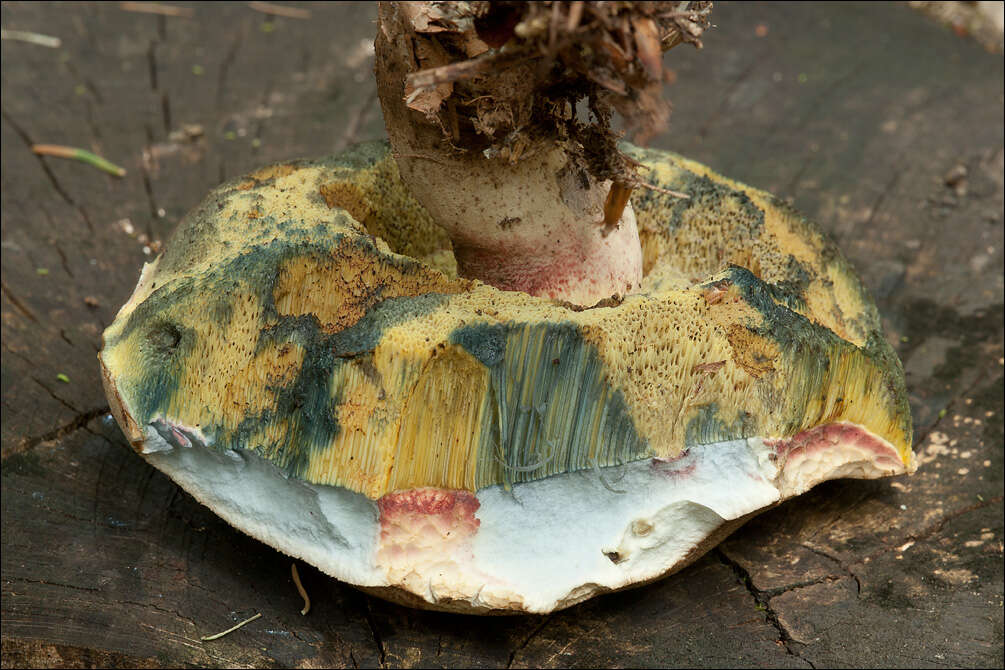
Boletus radicans (Pers.) Fr. syn. Boletus albidusWhitish bolete , Rooting bolete, DE: Wurzelnder BitterrhrlingSlo.: grenki gobanDat.: Jul. 16. 2015Lat.: 46.41048 Long.: 13.75046Code: Bot_902/2015_DSC7918Habitat: mixed mountain wood, dominant trees Fagus sylvatica and Picea abies; moderately steep mountain slope, south aspect; calcareous ground; in shade; partly protected from direct rain by tree canopies; average precipitations ~ 3.000 mm/year, average temperature 3-5 deg C, elevation 1.260 m (4.150 feet), alpine phytogeographical region.Substratum: forest soil.Place: Trenta valley, near Vri pass road, southwest slopes of Mt. Prisank, 2.547 , (8.357 feet), East Julian Alps, Posoje, Slovenia EC.Comments: Texture and color of the upper surface of the hut, rooting stipe, turning blue on bruising and, in particular, very strong bitter taste are typical traits of Boletus radicans. What surprises in this find is reddish coloration of damaged places (by snails) and quite distinctive reddish tones of the stipe. This is unusual with Boletus radicans and causes some doubts in our determination. However, no better alternatives have been found. Growing solitary; pileus diameter 8.5 cm; taste strongly bitter, smell faint, unpleasant; quickly bruising blue-green when handled; SP faint, color indistinguishable. Spores smooth. Dimensions: 12.4 [13.7 ; 14.2] 15.5 x 5 [5.5 ; 5.8] 6.3 microns Q = 2.2 [2.4 ; 2.5] 2.8; N = 34; C = 95%; Me = 14 x 5.6 microns; Qe = 2,5. Olympus CH20, NEA 100x/1.25, magnification 1.000 x, oil; in water. AmScope MA500 digital camera.Herbarium: Mycotheca and lichen herbarium (LJU-Li) of Slovenian Forestry Institute, Vena pot 2, Ljubljana, Index Herbariorum LJFRef.:(1) Personal communication with Mr. Bojan Rot and (conf.) Mr. Anton Poler.(2) G. Kibby, British Boletes, Copyright Geoffrey Kibby (2011), p 20. (3) R.M. Daehncke, 1200 Pilze in Farbfotos, AT Verlag (2009), p 72. (4) M. Bon, Parey's Buch der Pilze, Kosmos (2005), p 36. (5) S. Buczacki, Collins Fungi Guide, Collins (2012), p 406.
-
Boletus radicans, syn. Boletus albidusWhitish bolete , Rooting bolete Slo.: grenki gobanDate: August 21. 2009Lat.: 46.3929 Long.: 14.08478Code: Bot_373/2009-2470Habitat: Grassland with some bushes and Fagus sylvatica, mostly open place, pretty sunny, precipitations 1.800-2.000 mm/year, average temperature 8-10 deg C, elevation 600 m (1.970 feet), alpine phytogeographical region.Place: Blejski vintgar gorge, northwest of Bled, Gorenjska, Slovenia ECNikon D70 / Nikorr Micro 105mm/f2.8
-
Boletus radicans, syn. Boletus albidusWhitish bolete , Rooting bolete Slo.: grenki gobanDate: August 21. 2009Lat.: 46.3929 Long.: 14.08478Code: Bot_373/2009-2470Habitat: Grassland with some bushes and Fagus sylvatica, mostly open place, pretty sunny, precipitations 1.800-2.000 mm/year, average temperature 8-10 deg C, elevation 600 m (1.970 feet), alpine phytogeographical region.Place: Blejski vintgar gorge, northwest of Bled, Gorenjska, Slovenia ECNikon D70 / AF-S Nikorr 18-70mm/f3.5-4.5G ED
-
Boletus radicans, syn. Boletus albidusWhitish bolete , Rooting bolete Slo.: grenki gobanDate: August 21. 2009Lat.: 46.3929 Long.: 14.08478Code: Bot_373/2009-2470Habitat: Grassland with some bushes and Fagus sylvatica, mostly open place, pretty sunny, precipitations 1.800-2.000 mm/year, average temperature 8-10 deg C, elevation 600 m (1.970 feet), alpine phytogeographical region.Place: Blejski vintgar gorge, northwest of Bled, Gorenjska, Slovenia ECNikon D70 / Nikorr Micro 105mm/f2.8
-
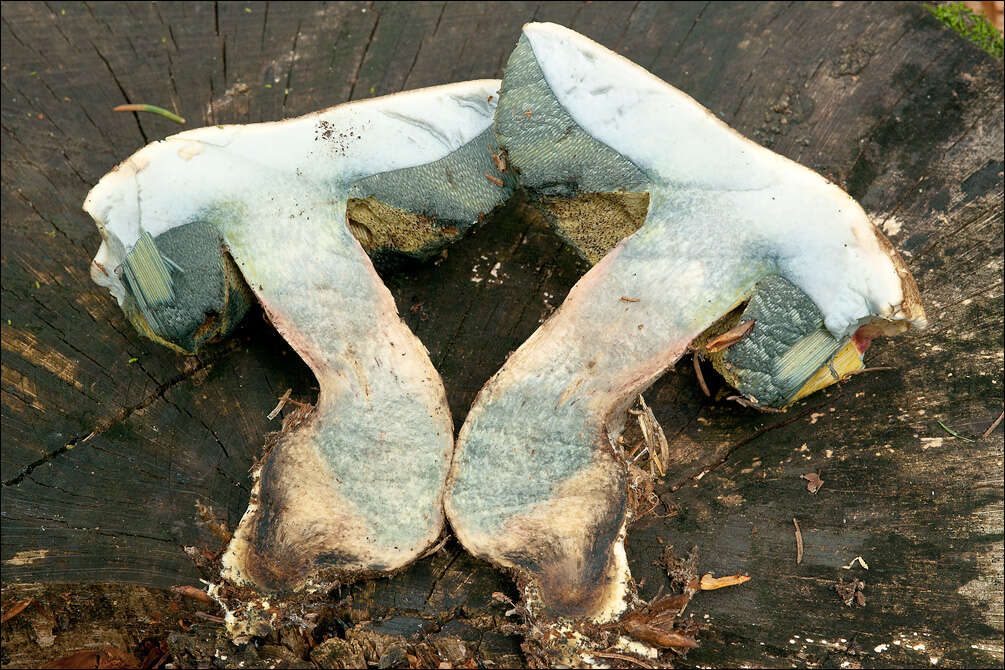
Boletus radicans (Pers.) Fr. syn. Boletus albidusWhitish bolete , Rooting bolete, DE: Wurzelnder BitterrhrlingSlo.: grenki gobanDat.: Jul. 16. 2015Lat.: 46.41048 Long.: 13.75046Code: Bot_902/2015_DSC7918Habitat: mixed mountain wood, dominant trees Fagus sylvatica and Picea abies; moderately steep mountain slope, south aspect; calcareous ground; in shade; partly protected from direct rain by tree canopies; average precipitations ~ 3.000 mm/year, average temperature 3-5 deg C, elevation 1.260 m (4.150 feet), alpine phytogeographical region.Substratum: forest soil.Place: Trenta valley, near Vri pass road, southwest slopes of Mt. Prisank, 2.547 , (8.357 feet), East Julian Alps, Posoje, Slovenia EC.Comments: Texture and color of the upper surface of the hut, rooting stipe, turning blue on bruising and, in particular, very strong bitter taste are typical traits of Boletus radicans. What surprises in this find is reddish coloration of damaged places (by snails) and quite distinctive reddish tones of the stipe. This is unusual with Boletus radicans and causes some doubts in our determination. However, no better alternatives have been found. Growing solitary; pileus diameter 8.5 cm; taste strongly bitter, smell faint, unpleasant; quickly bruising blue-green when handled; SP faint, color indistinguishable. Spores smooth. Dimensions: 12.4 [13.7 ; 14.2] 15.5 x 5 [5.5 ; 5.8] 6.3 microns Q = 2.2 [2.4 ; 2.5] 2.8; N = 34; C = 95%; Me = 14 x 5.6 microns; Qe = 2,5. Olympus CH20, NEA 100x/1.25, magnification 1.000 x, oil; in water. AmScope MA500 digital camera.Herbarium: Mycotheca and lichen herbarium (LJU-Li) of Slovenian Forestry Institute, Vena pot 2, Ljubljana, Index Herbariorum LJFRef.:(1) Personal communication with Mr. Bojan Rot and (conf.) Mr. Anton Poler.(2) G. Kibby, British Boletes, Copyright Geoffrey Kibby (2011), p 20. (3) R.M. Daehncke, 1200 Pilze in Farbfotos, AT Verlag (2009), p 72. (4) M. Bon, Parey's Buch der Pilze, Kosmos (2005), p 36. (5) S. Buczacki, Collins Fungi Guide, Collins (2012), p 406.
-
Boletus radicans, syn. Boletus albidusWhitish bolete , Rooting bolete Slo.: grenki gobanDate: August 21. 2009Lat.: 46.3929 Long.: 14.08478Code: Bot_373/2009-2470Habitat: Grassland with some bushes and Fagus sylvatica, mostly open place, pretty sunny, precipitations 1.800-2.000 mm/year, average temperature 8-10 deg C, elevation 600 m (1.970 feet), alpine phytogeographical region.Place: Blejski vintgar gorge, northwest of Bled, Gorenjska, Slovenia ECNikon D70 / Nikorr Micro 105mm/f2.8
-
Boletus radicans, syn. Boletus albidusWhitish bolete , Rooting bolete Slo.: grenki gobanDate: August 21. 2009Lat.: 46.3929 Long.: 14.08478Code: Bot_373/2009-2470Habitat: Grassland with some bushes and Fagus sylvatica, mostly open place, pretty sunny, precipitations 1.800-2.000 mm/year, average temperature 8-10 deg C, elevation 600 m (1.970 feet), alpine phytogeographical region.Place: Blejski vintgar gorge, northwest of Bled, Gorenjska, Slovenia ECNikon D70 / AF-S Nikorr 18-70mm/f3.5-4.5G ED
-
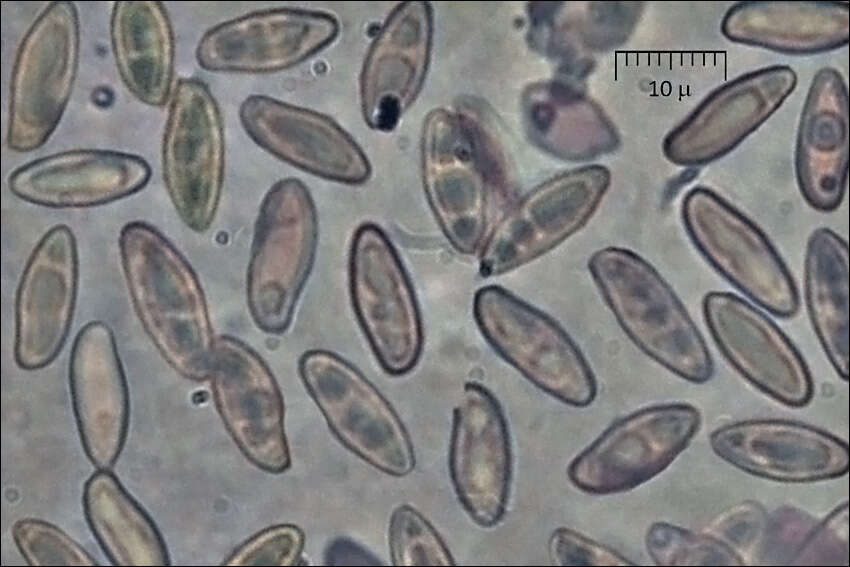
Boletus radicans (Pers.) Fr. syn. Boletus albidusWhitish bolete , Rooting bolete, DE: Wurzelnder BitterrhrlingSlo.: grenki gobanDat.: Jul. 16. 2015Lat.: 46.41048 Long.: 13.75046Code: Bot_902/2015_DSC7918Habitat: mixed mountain wood, dominant trees Fagus sylvatica and Picea abies; moderately steep mountain slope, south aspect; calcareous ground; in shade; partly protected from direct rain by tree canopies; average precipitations ~ 3.000 mm/year, average temperature 3-5 deg C, elevation 1.260 m (4.150 feet), alpine phytogeographical region.Substratum: forest soil.Place: Trenta valley, near Vri pass road, southwest slopes of Mt. Prisank, 2.547 , (8.357 feet), East Julian Alps, Posoje, Slovenia EC.Comments: Texture and color of the upper surface of the hut, rooting stipe, turning blue on bruising and, in particular, very strong bitter taste are typical traits of Boletus radicans. What surprises in this find is reddish coloration of damaged places (by snails) and quite distinctive reddish tones of the stipe. This is unusual with Boletus radicans and causes some doubts in our determination. However, no better alternatives have been found. Growing solitary; pileus diameter 8.5 cm; taste strongly bitter, smell faint, unpleasant; quickly bruising blue-green when handled; SP faint, color indistinguishable. Spores smooth. Dimensions: 12.4 [13.7 ; 14.2] 15.5 x 5 [5.5 ; 5.8] 6.3 microns Q = 2.2 [2.4 ; 2.5] 2.8; N = 34; C = 95%; Me = 14 x 5.6 microns; Qe = 2,5. Olympus CH20, NEA 100x/1.25, magnification 1.000 x, oil; in water. AmScope MA500 digital camera.Herbarium: Mycotheca and lichen herbarium (LJU-Li) of Slovenian Forestry Institute, Vena pot 2, Ljubljana, Index Herbariorum LJFRef.:(1) Personal communication with Mr. Bojan Rot and (conf.) Mr. Anton Poler.(2) G. Kibby, British Boletes, Copyright Geoffrey Kibby (2011), p 20. (3) R.M. Daehncke, 1200 Pilze in Farbfotos, AT Verlag (2009), p 72. (4) M. Bon, Parey's Buch der Pilze, Kosmos (2005), p 36. (5) S. Buczacki, Collins Fungi Guide, Collins (2012), p 406.
-
Boletus radicans, syn. Boletus albidusWhitish bolete , Rooting bolete Slo.: grenki gobanDate: August 21. 2009Lat.: 46.3929 Long.: 14.08478Code: Bot_373/2009-2470Habitat: Grassland with some bushes and Fagus sylvatica, mostly open place, pretty sunny, precipitations 1.800-2.000 mm/year, average temperature 8-10 deg C, elevation 600 m (1.970 feet), alpine phytogeographical region.Place: Blejski vintgar gorge, northwest of Bled, Gorenjska, Slovenia ECNikon D70 / AF-S Nikorr 18-70mm/f3.5-4.5G ED
-
Boletus radicans, syn. Boletus albidusWhitish bolete , Rooting bolete Slo.: grenki gobanDate: August 21. 2009Lat.: 46.3929 Long.: 14.08478Code: Bot_373/2009-2470Habitat: Grassland with some bushes and Fagus sylvatica, mostly open place, pretty sunny, precipitations 1.800-2.000 mm/year, average temperature 8-10 deg C, elevation 600 m (1.970 feet), alpine phytogeographical region.Place: Blejski vintgar gorge, northwest of Bled, Gorenjska, Slovenia ECNikon D70 / Nikorr Micro 105mm/f2.8
-

Boletus radicans (Pers.) Fr. syn. Boletus albidusWhitish bolete , Rooting bolete, DE: Wurzelnder BitterrhrlingSlo.: grenki gobanDat.: Jul. 16. 2015Lat.: 46.41048 Long.: 13.75046Code: Bot_902/2015_DSC7918Habitat: mixed mountain wood, dominant trees Fagus sylvatica and Picea abies; moderately steep mountain slope, south aspect; calcareous ground; in shade; partly protected from direct rain by tree canopies; average precipitations ~ 3.000 mm/year, average temperature 3-5 deg C, elevation 1.260 m (4.150 feet), alpine phytogeographical region.Substratum: forest soil.Place: Trenta valley, near Vri pass road, southwest slopes of Mt. Prisank, 2.547 , (8.357 feet), East Julian Alps, Posoje, Slovenia EC.Comments: Texture and color of the upper surface of the hut, rooting stipe, turning blue on bruising and, in particular, very strong bitter taste are typical traits of Boletus radicans. What surprises in this find is reddish coloration of damaged places (by snails) and quite distinctive reddish tones of the stipe. This is unusual with Boletus radicans and causes some doubts in our determination. However, no better alternatives have been found. Growing solitary; pileus diameter 8.5 cm; taste strongly bitter, smell faint, unpleasant; quickly bruising blue-green when handled; SP faint, color indistinguishable. Spores smooth. Dimensions: 12.4 [13.7 ; 14.2] 15.5 x 5 [5.5 ; 5.8] 6.3 microns Q = 2.2 [2.4 ; 2.5] 2.8; N = 34; C = 95%; Me = 14 x 5.6 microns; Qe = 2,5. Olympus CH20, NEA 100x/1.25, magnification 1.000 x, oil; in water. AmScope MA500 digital camera.Herbarium: Mycotheca and lichen herbarium (LJU-Li) of Slovenian Forestry Institute, Vena pot 2, Ljubljana, Index Herbariorum LJFRef.:(1) Personal communication with Mr. Bojan Rot and (conf.) Mr. Anton Poler.(2) G. Kibby, British Boletes, Copyright Geoffrey Kibby (2011), p 20. (3) R.M. Daehncke, 1200 Pilze in Farbfotos, AT Verlag (2009), p 72. (4) M. Bon, Parey's Buch der Pilze, Kosmos (2005), p 36. (5) S. Buczacki, Collins Fungi Guide, Collins (2012), p 406.
-
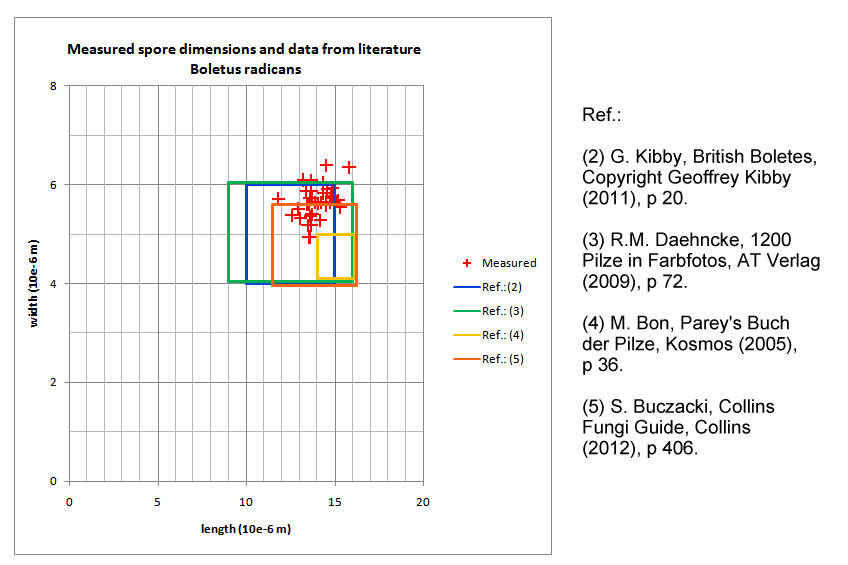
Boletus radicans (Pers.) Fr. syn. Boletus albidusWhitish bolete , Rooting bolete, DE: Wurzelnder BitterrhrlingSlo.: grenki gobanDat.: Jul. 16. 2015Lat.: 46.41048 Long.: 13.75046Code: Bot_902/2015_DSC7918Habitat: mixed mountain wood, dominant trees Fagus sylvatica and Picea abies; moderately steep mountain slope, south aspect; calcareous ground; in shade; partly protected from direct rain by tree canopies; average precipitations ~ 3.000 mm/year, average temperature 3-5 deg C, elevation 1.260 m (4.150 feet), alpine phytogeographical region.Substratum: forest soil.Place: Trenta valley, near Vri pass road, southwest slopes of Mt. Prisank, 2.547 , (8.357 feet), East Julian Alps, Posoje, Slovenia EC.Comments: Texture and color of the upper surface of the hut, rooting stipe, turning blue on bruising and, in particular, very strong bitter taste are typical traits of Boletus radicans. What surprises in this find is reddish coloration of damaged places (by snails) and quite distinctive reddish tones of the stipe. This is unusual with Boletus radicans and causes some doubts in our determination. However, no better alternatives have been found. Growing solitary; pileus diameter 8.5 cm; taste strongly bitter, smell faint, unpleasant; quickly bruising blue-green when handled; SP faint, color indistinguishable. Spores smooth. Dimensions: 12.4 [13.7 ; 14.2] 15.5 x 5 [5.5 ; 5.8] 6.3 microns Q = 2.2 [2.4 ; 2.5] 2.8; N = 34; C = 95%; Me = 14 x 5.6 microns; Qe = 2,5. Olympus CH20, NEA 100x/1.25, magnification 1.000 x, oil; in water. AmScope MA500 digital camera.Herbarium: Mycotheca and lichen herbarium (LJU-Li) of Slovenian Forestry Institute, Vena pot 2, Ljubljana, Index Herbariorum LJFRef.:(1) Personal communication with Mr. Bojan Rot and (conf.) Mr. Anton Poler.(2) G. Kibby, British Boletes, Copyright Geoffrey Kibby (2011), p 20. (3) R.M. Daehncke, 1200 Pilze in Farbfotos, AT Verlag (2009), p 72. (4) M. Bon, Parey's Buch der Pilze, Kosmos (2005), p 36. (5) S. Buczacki, Collins Fungi Guide, Collins (2012), p 406.
-
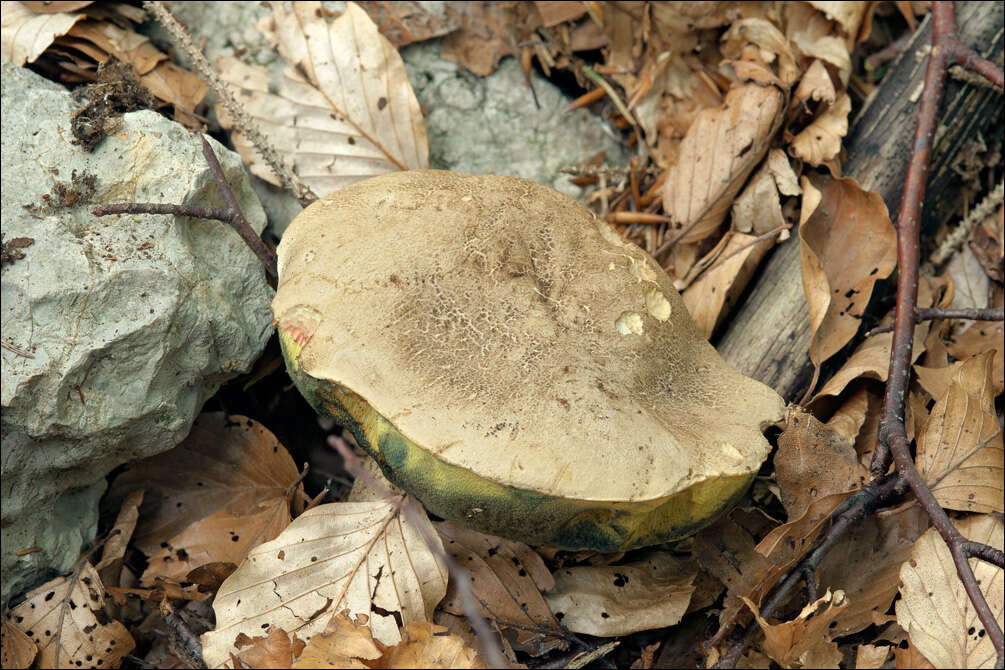
Boletus radicans (Pers.) Fr. syn. Boletus albidusWhitish bolete , Rooting bolete, DE: Wurzelnder BitterrhrlingSlo.: grenki gobanDat.: Jul. 16. 2015Lat.: 46.41048 Long.: 13.75046Code: Bot_902/2015_DSC7918Habitat: mixed mountain wood, dominant trees Fagus sylvatica and Picea abies; moderately steep mountain slope, south aspect; calcareous ground; in shade; partly protected from direct rain by tree canopies; average precipitations ~ 3.000 mm/year, average temperature 3-5 deg C, elevation 1.260 m (4.150 feet), alpine phytogeographical region.Substratum: forest soil.Place: Trenta valley, near Vri pass road, southwest slopes of Mt. Prisank, 2.547 , (8.357 feet), East Julian Alps, Posoje, Slovenia EC.Comments: Texture and color of the upper surface of the hut, rooting stipe, turning blue on bruising and, in particular, very strong bitter taste are typical traits of Boletus radicans. What surprises in this find is reddish coloration of damaged places (by snails) and quite distinctive reddish tones of the stipe. This is unusual with Boletus radicans and causes some doubts in our determination. However, no better alternatives have been found. Growing solitary; pileus diameter 8.5 cm; taste strongly bitter, smell faint, unpleasant; quickly bruising blue-green when handled; SP faint, color indistinguishable. Spores smooth. Dimensions: 12.4 [13.7 ; 14.2] 15.5 x 5 [5.5 ; 5.8] 6.3 microns Q = 2.2 [2.4 ; 2.5] 2.8; N = 34; C = 95%; Me = 14 x 5.6 microns; Qe = 2,5. Olympus CH20, NEA 100x/1.25, magnification 1.000 x, oil; in water. AmScope MA500 digital camera.Herbarium: Mycotheca and lichen herbarium (LJU-Li) of Slovenian Forestry Institute, Vena pot 2, Ljubljana, Index Herbariorum LJFRef.:(1) Personal communication with Mr. Bojan Rot and (conf.) Mr. Anton Poler.(2) G. Kibby, British Boletes, Copyright Geoffrey Kibby (2011), p 20. (3) R.M. Daehncke, 1200 Pilze in Farbfotos, AT Verlag (2009), p 72. (4) M. Bon, Parey's Buch der Pilze, Kosmos (2005), p 36. (5) S. Buczacki, Collins Fungi Guide, Collins (2012), p 406.

